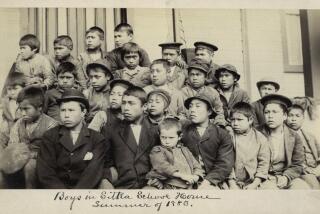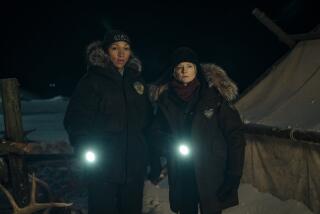Costner to Bring Indian History to CBS in 1994 : Television: The network has committed to running the eight-hour documentary â500 Nations,â in which the actor is investing $8 million.
âRootsâ made network-television history and âThe Civil Warâ made public-television history. The producers of â500 Nationsâ--especially Kevin Costner--hope their show will fall somewhere between the two.
The actor is gambling $8 million of his own money that an eight-hour documentary on the history of American Indians will be as big a hit with audiences as his fictionalized film account of one white manâs encounter with the Lakota Sioux was two years back.
â âDances With Wolvesâ was an isolated story; this is the whole story,â Costner said. âIâm not looking for a big movie all the time, Iâm looking for fresh air. A chance to play with a longer medium.â
CBS is willing to gamble with him. The network has agreed to broadcast at least the first two hours of â500 Nationsâ in prime time in 1994.
Costner will host the show and is co-executive producer with Jim Wilson, who also produced the multi-Oscar-winning âDances With Wolves,â though the series is being produced by Pathways Prods. in association with Costnerâs own Tig Productions, which is based at Warner Bros. studios. Foreign sales will be handled by Majestic Film and Television International, which distributed âDances With Wolvesâ overseas, and video by the Italian entertainment company RCS Video.
If the credits already seem complicated, itâs a reflection of the complexity of the production, which intends, as the title suggests, to give the American Indian perspective on the indigenous populations that lived here thousands of years before the arrival of Columbus. The series stops at Wounded Knee, a battle that many Indians consider to be the symbolic end of Indian sovereign rights, with an epilogue on the state of Indian societies today.
It will cover Indian nations living throughout a massive geographic region--all 50 states, Canada, Mexico and the Caribbean--and will incorporate exclusive location footage, historical pictures, matte paintings, photographs and as many as 100 interviews with scholars, historians and Indians. Voice-over narration will be used for only those parts not spoken by actors reading for historical figures or for Indians speaking their own stories.
The key model for the show is PBSâ record-breaking series âThe Civil War,â whose producer Ken Burns met with â500 Nationsâ senior producer Jack Leustig when the new series was getting off the ground several months ago. Leustig, along with Costner and Wilson, got the fever to bring the bigger story of the Indian to the American people after âDances With Wolvesâ unexpectedly caught fire with moviegoers.
He recalls their breakfast: âKen said he hoped weâd pull it off--make history by drawing a commercial television audience for a documentary the way he did intellectuals on PBS.â
Quite a challenge, they admit. Ratings that are somewhere between âRootsâ and âThe Civil Warâ are hardly comparable--the former garnered an estimated audience of 80 million and the latter 14 million. A hit for a network miniseries falls in the 35 million viewer range.
And thereâs a competing six-hour series planned for TBS in fall, 1993, âThe First Americans,â written by Pulitzer Prize-winning author and Kiowa Nation descendant Scott Momaday.
But Jeff Sagansky, president of CBSâ entertainment division, counters that the networks need to âtake more chancesâ in programming. And with Costnerâs name attached as executive producer, and more importantly as host, â500 Nationsâ got the green light.
âCertainly judging from âThe Civil Warâ--when (documentaries) are done well, they can be just as entertaining as a (feature) film,â Sagansky said.
Certainly, thatâs the mandate for the producers.
âWeâre not going to overromanticize or mythologize people,â said Lisa Sonne, a producer-writer whose previous credits include the Academy Award-winning documentary âBroken Rainbowâ about the Hopi and Navajo tribes. âIn this time of cultural diversity, this documentary gives an opportunity to become aware of the civilizations that rose and fell on this continent.â
To enliven the proceedings, the producers say that many of the voices behind â500 Nationsâ will be those of stars of Costnerâs caliber and that major recording artists will be signed for the soundtrack.
The producers are quick to say the series is not ârevisionist,â where re-analysis of historical events often indict historical figures once thought heroic, like Columbus. Rather, the aim is to dispel the myths of Indians as one-dimensional Hollywood characters or as shamans.
âHollywood seems to find only one Indian identity and the main characters were always white. Now, itâs up to us to take this story and have our say,â said Lee Miller, a Cherokee and former consultant to the Library of Congress. She is also just one of a number of American Indians on the production team hired as consultants or writers.
In this way, the series will avoid possible criticisms that it is âa white manâs approachâ to Indian history, said Wilson. And, presumably, the same kind of scrutiny aimed at âDances With Wolvesâ for being historical hokum colored with a new-age wash, as some critics said.
One of the stories that will be told is the relocation of tens of thousands of Cherokee from the Smoky Mountains to the Indian territories of Oklahoma. The massive displacement caused the death of a fourth of the Nation and is recounted by Cherokee today as âThe Trail of Tears.â
For all the Indian stories, in fact, Miller will seek script approval from a learned representative of that tribe whose historical tales become segments in the show.
Columbus may loom large in the development of the New World, but he plays only a historical footnote in this series. Instead of focusing upon his meeting the Arawak Indians in the Caribbean, the perspective of â500 Nationsâ focuses upon the battle between the Aztecs and the Mixtecs in Mexico fought by 400,000 warriors in Mesoamerica (what is today southern Mexico). Farther north, through three-dimensional computer re-creations enhanced by virtual reality, such little known ancient monuments as the Cahokia pyramid in what is now East St. Louis--then the worldâs fourth-largest--will be re-created for dramatic effect.
âHistorical epics in the movies have brought the Greeks and the Romans to life like âSpartacus,â so now thereâs this whole untapped source for new stories,â said John Pohl, Ph.D., a research archeologist at UCLAâs Fowler Museum of Cultural History, who balances his academic life with overseeing the archeological model-making on this show and creating videos for MTV.
Considering the theme hangs on the historical facts that many hundred thousand Indians died, were slaughtered or resettled to uncertain futures by the settlers, the impression is that the series will be downbeat. Not so, they say.
âIt should be poignant, not accusing. People should know the tragedy without feeling the guilt,â said Miller.
âDemocracy has roots in the Iroquois. Other Nations understood ecology and mansâ balance in the environment,â said Sonne.
Despite the producersâ noble intentions, the series is still subject to the constraints of all network television entertainment. Although CBS is committed to running the first two hours in prime time, Sagansky would not say when the rest of the series would be broadcast.
More to Read
The complete guide to home viewing
Get Screen Gab for everything about the TV shows and streaming movies everyoneâs talking about.
You may occasionally receive promotional content from the Los Angeles Times.






